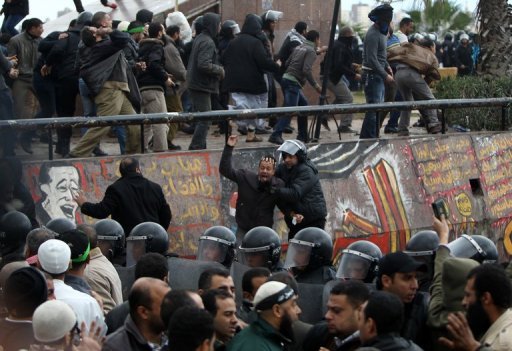 Protests in Alexandria, 21 December (Photo: Mahmud Hams/AFP)Abdelrahman Youssef, writing for the Egypt Independent, describes the political and social complexity beyond the label of "Islamist" for movements in Egypt's second city Alexandria:
Protests in Alexandria, 21 December (Photo: Mahmud Hams/AFP)Abdelrahman Youssef, writing for the Egypt Independent, describes the political and social complexity beyond the label of "Islamist" for movements in Egypt's second city Alexandria:
Many of the protest scenes that played out over the past weeks are emblematic of substantive changes in the landscape of Islamist movements, particularly in Alexandria, according to observers.
After President Mohamed Morsy’s controversial 22 November constitutional declaration --- revoked on 8 December --- youth from several revolutionary movements were surprised to find non-Brotherhood, Islamist political groups gathered to support the decisions at Al-Qaed Ibrahim Mosque in Alexandria, which has been at the heart of protests since the outbreak of the 2011 uprising.
The scene confounded reporters who wondered about the demographics of those gathered at Al-Qaed Ibrahim, especially since both the Muslim Brotherhood and the Salafi Dawah said they had not organized protests there. The tens of thousands of apparent Islamist protesters amassed in the area raised the question: Which political force has the capability to mobilize a rally of this size?
Alexandria is known to be a Brotherhood stronghold and is also home to some of the group’s most prominent leaders, including Essam al-Haddad and Hussein Ibrahim. It was also in this city that the Salafi movement was established, namely the Alexandria school of the Salafi Dawah in 1979.
But after the revolution, several loosely organized Islamist movements have emerged, influenced by recent developments and new ideas, including Hazemoun, the Third Islamist Current and the Salafi Front. Jama’a al-Islamiya and other jihadi movements have also made a strong comeback to the political scene.
Nageh Ibrahim, Islamist preacher and thinker and one of the founders of Jama’a Islamiya, says there are stark differences between these fledgling Islamist movements and more established ones, chief among which are their fluidity and lack of a strict organizational structure.
They are also characterized by diversity and intellectual variability among members, most of whom prefer to remain independent rather than pledge loyalty to a specific organization, Ibrahim says. The newer movements are not institutionalized and are at times personalized, as in the case of Hazemoun, which was formed during the presidential election in support of its namesake, former Salafi candidate Hazem Salah Abu Ismail.
While growing exponentially in some areas, the groups do not have an equally strong presence nationwide.
Ibrahim says the Salafi Front has a significant presence in the Delta, particularly in Mansoura, while Hazemoun is strong in Cairo. Meanwhile, Jama’a Islamiya is potent in Upper Egypt while the Third Islamist Current was born in Alexandria.
“The mass protests staged by Islamists are beyond the mobilization capacity of known Islamist groups, and a considerable number of protesters in those rallies came out in defense of the Islamic project rather than a certain Islamist faction,” says Ibrahim.
***
Osama al-Shafie, secretary for the Third Current Shura Council in Alexandria, says the movement was born three months after the breakout of the revolution, when a large sector of people began wanting to engage in Islamist political activity, but in a nonpartisan way. They shared an aversion to the Brotherhood’s reformist platform as well as the Salafi Dawah’s conservative nature in dealing with reality, "focusing primarily on superficial changes and formalities, while rejecting the idea of revolting against the ruler".
“The current brings together people who reject both groups, as well as tyranny,” he explains, adding that the current has thousands of members and 15 mosques in Alexandria, and is funded by members.
The flag used by the movement is white with black writing that says “There is no god but Allah and Mohamed is his Prophet,” indicating that it does not fall under a specific organization, with the Shura Council, comprised of five sheikhs, running its affairs.
Mahmoud Hassan, a 30-year-old member, was part of the committee securing one of the recent protests. He joined the Third Current and Hazemoun after sensing that the Salafi movement was not taking a serious enough position to face the social and media systems, or the smearing of their image by the regime and secularists.
He also joined the movement because it is nonpartisan in nature and does not oblige him to adopt certain opinions, unlike mainstream Salafis and the Brotherhood.
Ibrahim asserts this reasoning as the roots for many emerging Islamist movements.
He says the rise of these new powers can be attributed to the fact that the engagement of Islamist movements in politics comes at the expense of their religious credibility, due to the political compromises they have to make. The people have yet to test the new Islamist powers, however, he adds.